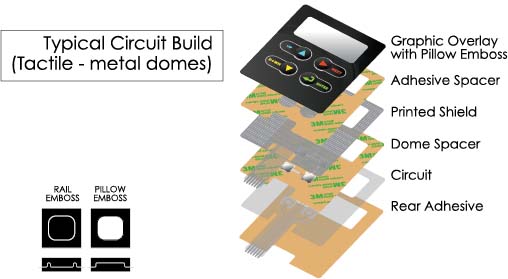The Benefits of Utilizing Membrane Switches in Customer Electronics
Membrane layer switches are increasingly recognized for their substantial benefits in customer electronic devices, specifically in improving user communication and enhancing manufacturing processes. Their ability to supply user-friendly user interfaces and tactile feedback can greatly minimize user errors, while their light-weight building and simplified production actions contribute to cost-effectiveness and quicker market entry. The adaptability in style permits for tailored options that meet varied consumer requirements. The effects of these benefits prolong beyond mere functionality, hinting at a transformative capacity for the future of electronic devices. What additional benefits might become this modern technology evolves?
Boosted Individual Experience
In today's affordable landscape of customer electronics, enhanced customer experience is paramount; nearly 85% of customers focus on user-friendly interfaces. Membrane switches play an essential role in accomplishing this level of use. Their level, inconspicuous layout permits for smooth integration right into numerous devices, reducing mass while keeping capability. This style aesthetic not only boosts the aesthetic appeal but likewise contributes to a more streamlined customer interaction.
The tactile responses offered by membrane buttons is vital for guiding customer activities, making certain that commands are registered accurately. This comments mechanism enhances and decreases mistakes user satisfaction, fostering a positive partnership in between the user and the tool. The adjustable nature of membrane layer switches permits producers to customize user interfaces to certain customer requirements, making tools more easily accessible and welcoming.
In addition, membrane layer switches can incorporate backlighting and visuals overlays, even more enhancing visibility and functionality in diverse atmospheres. This adaptability ensures that tools stay practical and straightforward, no matter the setup. Overall, the integration of membrane switches over into customer electronic devices substantially improves user experience, driving brand loyalty and fulfillment in a significantly open market.
Cost-Effective Production
Customer electronics producers are frequently seeking means to stabilize quality with cost, and membrane buttons provide an engaging solution for affordable production. membrane switch. These elements are inherently less complex than conventional mechanical buttons, which reduces both production expenses and complexity. The lightweight design of membrane switches over permits lower shipping expenditures and less complicated assimilation into portable devices, better enhancing their charm in an open market

Suppliers can produce membrane switches in high volumes, taking benefit of economic climates of scale. This automation capacity ensures constant quality while substantially lowering per-unit expenses. Furthermore, the materials utilized in membrane layer switches, such as polyester and polycarbonate, are usually more economical than those required for traditional switch technologies, adding to overall price savings.
The manufacturing procedure for membrane layer switches usually requires less steps and less labor compared to various other switch kinds. This streamlined technique not just conserves on labor expenses but also speeds up time-to-market, permitting firms to respond swiftly to customer demand. Subsequently, the mix of reduced material expenditures and reliable production processes settings membrane switches as a clever financial investment for producers aiming to deliver top quality customer electronics at competitive cost factors.
Layout Flexibility and Modification
While traditional mechanical switches frequently enforce limitations on style because of their bulk and required installing devices, membrane buttons offer exceptional versatility and customization alternatives for consumer electronics. This cutting-edge technology enables designers to develop smooth, inconspicuous user interfaces that can seamlessly Home Page integrate right into various product looks, from smart devices to kitchen home appliances.
Membrane buttons can be produced in essentially any form or size, enabling manufacturers to customize the layout to particular ergonomic and practical needs. This versatility not only improves individual experience but also permits creative designs that line up with brand name identity. In addition, using printed graphics on membrane layer changes supplies the possibility for dynamic colors and elaborate layouts, which can be quickly modified without substantial price ramifications.
Additionally, membrane layer buttons can integrate multiple functionalities into a single layer, reducing the demand for numerous parts and streamlining setting up processes. This structured style method lessens space and weight, making it suitable for small consumer electronics. On the whole, the design versatility and customization capacities of membrane switches empower suppliers to introduce, inevitably leading to even more engaging and easy to use items.
Resilience and Reliability
As innovation remains to progress, the sturdiness and reliability of membrane layer buttons have come to be crucial considerations for manufacturers in the customer electronics market. Membrane switches are made to withstand severe environmental conditions, including temperature changes, moisture, and dirt direct exposure. Their durable construction usually entails multi-layered materials that supply an effective barrier against impurities, making sure longevity and constant efficiency.
Along with ecological resistance, membrane changes deal remarkable mechanical reliability. Unlike conventional mechanical buttons, which might wear with time, membrane layer switches make use of a closed style that lessens the threat of mechanical failing. The absence of moving components not just boosts their life-span however likewise minimizes damage, making them suitable for high-usage applications.
In addition, membrane layer switches can endure a considerable variety of actuations without loss of capability, often exceeding millions of cycles (membrane switch). This longevity converts to lower substitute prices and decreased downtime for customers and manufacturers alike. Generally, the combination of environmental resilience and mechanical dependability makes membrane changes a calculated selection for consumer electronics, ensuring that devices stay reliable and operational throughout their intended life expectancy

Streamlined Item Development
The durability and dependability of membrane layer switches over significantly add to streamlined item advancement in the customer electronics field. By incorporating these buttons early in the style process, makers can minimize the like this intricacy and variety of components required in their products. Membrane switches are lightweight and portable, permitting extra reliable area utilization within tools, which can result in simplified assembly procedures.

The convenience of manufacturing membrane layer switches also plays an essential duty in product development. With modern-day printing strategies and products, production can be scaled successfully, decreasing lead times and reducing waste. This results in reduced production costs, boosting overall earnings.

Verdict
To conclude, membrane switches considerably improve consumer electronic devices by providing an improved individual experience, economical production processes, and functional style alternatives. Their toughness and dependability make certain regular performance in different atmospheres, while streamlined product advancement assists in quicker time-to-market. These benefits jointly add to the technology and capability of consumer tools, dealing with the developing demands of customers effectively. The assimilation of membrane changes represents a critical selection for makers looking for to maximize product design and performance.
Membrane layer switches are significantly recognized for their considerable benefits in customer electronics, especially in boosting individual interaction and enhancing production procedures. Additionally, the materials made use of in membrane layer switches, such as polyester and polycarbonate, are often less costly than those required for conventional switch modern technologies, adding to overall cost financial savings.
The production process for membrane layer changes generally requires fewer actions and much less labor contrasted to various other button types. Unlike conventional mechanical switches, which might use out over time, membrane layer changes use a covered style that reduces the risk of mechanical failure.In conclusion, membrane link changes considerably improve consumer electronic devices by supplying a boosted user experience, affordable manufacturing procedures, and versatile style options.
 Josh Saviano Then & Now!
Josh Saviano Then & Now! Mackenzie Rosman Then & Now!
Mackenzie Rosman Then & Now! Michael Fishman Then & Now!
Michael Fishman Then & Now! Tina Majorino Then & Now!
Tina Majorino Then & Now! Ryan Phillippe Then & Now!
Ryan Phillippe Then & Now!